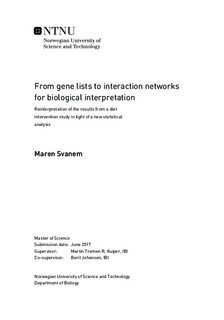From gene lists to interaction networks for biological interpretation - Reinterpretation of the results from a diet intervention study in light of a new statistical analysis
Master thesis
Permanent lenke
http://hdl.handle.net/11250/2447538Utgivelsesdato
2017Metadata
Vis full innførselSamlinger
- Institutt for biologi [2615]
Sammendrag
The results of a diet intervention study aiming to enlighten dietary carbohydrates role in proinflammatory responses have been reviewed in light of a new statistical analyses conducted on the microarray data. Two diets, a high-carb (AHC) diet and a moderate-carb (BMC) diet have been studied. The resulting gene expression data have been analyzed internally at NTNU, and subsequently by an external partner, KUL. Overlaps and differences between the diets and between the results of the two analyses performed have been addressed using a system-approach for biological interpretation. The analysis conducted in this project was carried out using a variety of software tools and is based on an already existing data sets. The gene sets were used for building of a regu-latory network and for further analysis, specifically with respect to changes in proinflammatory pathways.
The genes affected by the diets and the processes they influence can indeed be related to proinflammatory processes. There have been induced some changes on a transcriptional level in the participants of the diet intervention study, even though the changes barely are perceived as considerable. Every gene that has been studied shows similar change in both diets, if they are upregulated in AHC, they are also upregulated in BMC. The same pattern is also observed for downregulation. After taking KUL s data into consideration and interpreting the results in a new manner, the connection to a proinflammatory response is weakened compared to what was presented in the initial study. The tendencies are, however, existing.
